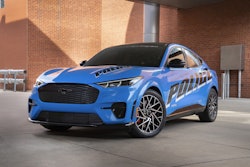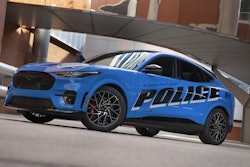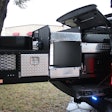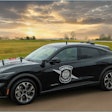Each year the Michigan State Police Vehicle Test Team takes all of the latest pursuit-rated vehicles from America’s Big Three automakers out to the track and puts them through their paces. The published results of their testing are one of the gold standards for police vehicle performance analysis.
For the 2021 model year patrol vehicle, the MSP ran their tests in October 2020, with a special test of the Ford F-150 Police Responder pursuit-rated pickup truck in March 2021.
The following is a look at the latest patrol SUVs and sedans with a discussion of their performance in the MSP testing.
![[|CREDIT|]](https://img.policemag.com/files/base/bobit/publicsafety/image/2021/09/pm.2021-chevrolet-tahoe-police-pursuit-vehicle-101.jpg?auto=format%2Ccompress&fit=max&q=70&w=400)
Chevrolet
General Motors currently makes two versions of the pursuit-rated Tahoe SUV, the 5.3L Chevrolet Tahoe with rear-wheel drive and the Chevrolet Tahoe 5.3L with four-wheel drive.
The 5.3L Tahoe with rear-wheel drive is powered by a hefty V8 engine that produces 335 horsepower and 385 foot-pounds of torque. Because of all that power, GM mechanically limits the top speed to 130 mph. The four-wheel drive version of the patrol Tahoe comes with the same engine and 10-speed automatic transmission as the rear-wheel drive Tahoe. EPA estimated mileage for the Tahoe RWD is 15 city, 19 highway, and 16 combined. The Tahoe 4WD has an EPA estimated mileage of 14 city, 18 highway, and 16 combined.
In acceleration testing conducted by the MSP, the 2021 Tahoe 5.3L with rear-wheel drive hit a top speed of 130 mph (manufacturer limit) in 1.41 miles and in 51.21 seconds. It reached 100 mph in 0.34 miles, clocking in at 19.17 seconds. The Tahoe 5.3L with four-wheel drive had a slightly slower top speed of 125 mph. But it reached that top speed in significantly less distance and time, 1.06 miles and 42.38 seconds. It reached 100 mph in 20.19 seconds.
During the MSP brake testing, the Tahoe four-wheel drive performed slightly better than the rear-wheel-drive model. The Tahoe RWD went from 60 mph to stopped in a projected distance of 127.4 feet with no evidence of severe brake fading. The Tahoe 4WD performed the same 60 mph to zero deceleration in a projected 127.1 feet, also with no evidence of brake fade.
![[|CREDIT|]](https://img.policemag.com/files/base/bobit/publicsafety/image/2021/09/pm.dodgetch21us4_007_r2.jpg?auto=format%2Ccompress&fit=max&q=70&w=400)
Dodge
As detailed in a recent cover story in POLICE (“The Last Patrol Sedan,” POLICE June 2021), the Dodge Charger is the only American pursuit-rated sedan on the market. It is available in two different versions a V6 3.6L with all-wheel drive and the 5.7L V8 with rear-wheel drive.
The 3.6L AWD Dodge Charger features a V6 Pentastar dual overhead cam 24-valve engine that produces 300 horsepower and 260 foot-pounds of torque. That Pentastar V6 is paired with a TorqueFlite 8-speed automatic transmission with overdrive. EPA mileage estimates for the 2021 3.6L AWD Charger are 18 city, 27 highway, and 21 combined.
The 2021 V6 Charger with AWD is turning some heads among Charger customers. Catherine Brown, director of the Fleet and Facilities Division of the Missouri State Highway Patrol, says the agency’s 495 Chargers are all V8s but it is now buying the new V6. “We wanted to continue with the AWD feature, given our location in the Midwest and the varying weather conditions we experience,” she explains.
Of course, If agencies need more power, they can get a Hemi. The Dodge Charger 5.7L with rear-wheel drive features a V-8 Hemi that generates 370 horsepower and 395 foot-pounds of torque. Pairing that legendary engine with a TorqueFlite 8-speed automatic transmission produces some serious performance. EPA mileage estimates for the 5.7L Charger are 16 city, 25 highway, and 19 combined. The 5.7L Hemi features variable valve timing that increases power and enhances fuel economy.
Chargers have been known for speed back to their 1960s and 1970s glory days. And the 2021 police Chargers did not disappoint during the MSP speed testing. Both hit a top speed of 140 mph.
The Charger 3.6L AWD hit 100 mph in 0.31 miles, 120 mph 0.67 miles. It reached its 140 mph top speed in a distance of 2.31 miles with a time of 94.19 seconds.
That’s solid performance for a V6. But the Hemi is a track-burning beast. The Charger 5.7 RWD with Hemi V8 hit the same top speed as the V6 charger. But that’s clearly not all it can do, as shown by its acceleration stats. The Hemi Charger hit 100 mph in 0.24 miles, 120 mph in 0.46 miles, and 140 mph in 1.01 miles. It hit that top speed in 35.87 seconds.
Braking for the Charger models was also impressive. The projected stopping distance for the 3.6L AWD from 60 mph to dead stop was 127.2 feet and the testers saw no evidence of brake fade. The 5.7L stopped from 60 mph to zero in a projected 128.8 feet based on deceleration tests.
Dodge makes two versions of its pursuit-rated Durango SUV: the 3.6L All-Wheel Drive and the 5.7L All-Wheel Drive.
The 2021 Dodge Durango 3.6L AWD is powered by a Pentastar V6 that produces 293 horsepower and 260 foot-pounds of torque. That powerful and economical engine is paired with a TorqueFlite 8-speed automatic transmission for solid gas mileage. EPA estimates score the Durango 3.6L AWD at 18 mpg city, 25 highway, and 21 combined.
When you see 5.7L on a Dodge vehicle, that means Hemi, and the 2021 Dodge Durango 5.7L AWD is no exception. It’s powered by a Hemi V8 that generates 360 horsepower and 390 foot-pounds of torque. That Hemi is paired with a TorqueFlite 8-speed automatic transmission. EPA mileage estimates are 14 city, 22 highway, and 17 combined.
SUVs like the Durango are by far the most popular patrol vehicles in America and one of the reasons is the performance they offer. At the MSP testing, the 2021 Durango 3.6L hit a top speed of 128 mph. Its acceleration was solid for a V6 SUV, reaching 100 mph in 0.46 miles, 120 mph in 1.16 miles, and top speed in 2.84 miles. The time to reach top speed was 95.89 seconds. Of course, the 5.7L V8 Hemi’s acceleration made the V6 look like it was standing still. It hit 100 mph in 0.34 miles, 120 mph in 0.72 miles, and its top speed of 130 mph in 1.12 miles at a time of 42.60 seconds.
In Durango’s deceleration testing, the 3.6L model had a projected 60 mph to zero stopping distance of 133.1 feet. But the true test of the Durango’s brake engineering is stopping the 5.7L with the Hemi. And it does a remarkable job. Based on its testing, MSP projects that the 60 mph to zero stopping distance for the 5.7L Durango is 132.7 feet. Both SUVs stopped in a straight line with no noticeable brake fade.
![[|CREDIT|]](https://img.policemag.com/files/base/bobit/publicsafety/image/2021/09/pm.2021_f-150_police_responder_1.jpg?auto=format%2Ccompress&fit=max&q=70&w=400)
Ford
For 2021 there are three different versions of the Ford Police Interceptor Utility: the PI Utility Hybrid with all-wheel drive, the PI Utility 3.0L EcoBoost with all-wheel drive, and the PI Utility 3.3L with all-wheel drive. All of the PI Utility models are designed and engineered to pass the 75-mph rear impact crash test.
The Ford PI Utility Hybrid AWD is the only hybrid engine patrol vehicle now on the market and it is the standard version of the PI Utility. It is powered by a 3.3L hybrid gas electric engine that produces 318 combined horsepower and 322 combined foot-pounds of torque. The powerful gas electric hybrid engine in this patrol SUV is paired with a 10-speed automatic transmission.
Gas mileage for the PI Utility Hybrid AWD is hard to measure by EPA standard testing. The EPA rates the hybrid patrol SUV at 23 city, 24 highway, and 24 combined. But it’s important to note that the hybrid engine changes that equation, especially in police work. The real fuel expenditure in law enforcement patrol operations is leaving the vehicle running while it’s parked at a scene so that it can keep the battery charged to run lights, radios, air conditioning, computers, and other stuff that draws current. The PI Utility hybrid can do that without the engine running. It uses the hybrid batteries and if the charge starts to get low on the batteries it will run the engine just long enough to give them a boost.
The PI Utility 3.0L EcoBoost with all-wheel drive features a direct injection gasoline engine with turbo boost, hence the name “EcoBoost.” With the punch of its twin turbos, the 3.0L EcoBoost produces 400 horsepower and 415 foot-pounds of torque, making the PI Utility 3.0L one of the most powerful patrol vehicles on the market. Paired with a 10-speed automatic transmission, the 2021 PI Utility 3.0L EcoBoost with AWD scores an EPA mileage estimate of 17 city, 22 highway, and 19 combined.
Ford’s third 2021 patrol SUV is thePI Utility 3.3L with all-wheel drive. The 3.3L V6 naturally aspirated gasoline engine in this patrol SUV produces 285 horsepower and 260 foot-pounds of torque. This engine is paired with a 10-speed automatic transmission. EPA mileage estimate for the PI Utility 3.3L with AWD is 17 city, 23 highway, and 19 combined.
MSP performance testing of the 2021 PI Utility models proves one thing: Ford makes some really fast SUVs. The PI Utility Hybrid with all-wheel drive topped out at 136 mph. But the real eye-opening stats for the PI Utility Hybrid are found in its acceleration numbers. It hit 100 mph in 0.30 miles, 120 mph in 0.61 miles, and reached its top speed in 1.28 miles at a time of 46.12 seconds.
The PI Utility Hybrid is relatively slow compared to the PI Utility 3.0L EcoBoost. Direct injection and turbo boost give this patrol SUV some serious power. MSP rated the top speed at 148 mph. And it’s quick, too. Distance to reach 100 mph is 0.24 miles, 120 mph in 0.45 miles, and the distance to reach 148 mph is 1.24 miles. The time to reach top speed was clocked at 41.57 seconds.
The third version of the PI Utility offered by Ford in 2021 is the 3.3L with all-wheel drive. It scored a top speed of 136 mph. Distance to 100 mph is 0.33 miles, 120 mph is 0.72 miles, and top speed was reached in 1.78 miles. Time to reach top speed was clocked at 61.35 seconds.
Ford’s SUVs stopped as impressively as they hauled it down the test track. MSP testing of the PI Utility Hybrid with all-wheel drive yielded a projected 60 mph to zero stopping distance of 130.1 feet with no evidence of severe brake fading. The PI Utility 3.0L EcoBoost with all-wheel drive performed slightly better with a projected 60 mph to zero stopping distance of 129.0 feet. And the PI Utility 3.3L with all-wheel drive decelerated from 60 mph to dead stop in 126.6 feet. All three Ford SUVs stopped in a straight line.
In March Ford announced a new version of the F-150 Police Responder, the world’s only pursuit-rated pickup. The 2021 F-150 is powered by a 3.5L EcoBoost engine that produces 400 horsepower and 500 foot-pounds of torque for a top speed of 120 mph. In addition to an increase in top speed over the previous version of the F-150 Police Responder, the new model offers a torque-on-demand 4x4 transfer case.
The 2021 Ford F-150 Police Responder is in a word “quick.” Its top speed of 120 mph is not a world beater. But its acceleration was very impressive. In four runs of zero to 60 mph, MSP averaged a time of 5.40 seconds. At 0.23 miles, the pursuit-rated pickup truck reached 100 mph at an average of 13.09 seconds. The average distance to reach 120 mph was 0.51 miles. And it hit that top speed in 21.46 seconds. That’s muscle car acceleration for a pickup truck with a curb weight of more than 5,000 pounds.
Brake testing of the 2021 f-150 police responder led MSP’s experts to project a stopping distance of 153.2 feet, significantly more than Ford’s patrol SUVs. There was no evidence of severe brake fade and the truck stopped in a straight line.



















